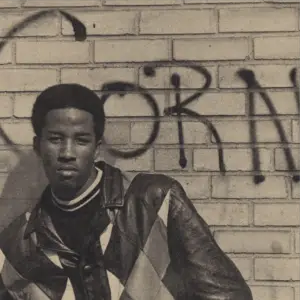Is graffiti art? Is it a nuisance? Who decides this and why? Graffiti has existed as long as humans, serving as a means of self-expression and communication. It is a creative outlet that is important to society. This article will talk about the notion of whether graffiti is good or bad art.
What is graffiti?

Britannica defines graffiti as a “form of visual communication, usually illegal, involving the unauthorized marking of public space by an individual or group.” Modern graffiti started as tagging, which is writing one’s name. Soon, it evolved to be street art. Stenciling, tagging, pieces (short for masterpieces), and many others are now popular styles under the umbrella term graffiti.
Cavemen graffitied the cave walls with their cave art. Greeks and Romans etched their marks into the walls of Pompeii. Soldiers drew the popular “Kilroy Was Here” motif across walls and bodies.
But the modern street art movement started in the 1960s, with street artist Cornbread commonly recognized as the initiator of this movement.

Born Darryl McCray, Cornbread began his graffiti career by writing the words “Cornbread Loves Cynthia” on the path he and his crush, Cynthia, took home from junior high every day. After many copied his style of writing on walls with markers, he switched his go-to medium to spray paint, which is still commonly used in the street art world. Then, he started to paint in “heaven spots,” places that are difficult to reach. He had many other projects, such as when he graffitied an elephant to prove the allegations that he had died were wrong. Everything that Cornbread did had effects on the entire modern street art movement.
Other Recognizable Street Artists

A commonly recognized name today, even outside the street art world, is Banksy. Banksy is an anonymous street artist, most popular for his stencil style. He has become famous because of his stunts, such as the Guantanamo Bay prisoner at Disneyland stunt, or the shredding of his painting as it was being auctioned off.
Another well-known name is Keith Haring. He is known for his unique art style and his common motifs of a baby and a dog. Haring was also known for his ideas that art should be accessible to all people. So, his art was commonly found in subway stations and other high-traffic areas.
What is good art?
The Oxford Dictionary defines art as “the use of the imagination to express ideas or feelings, particularly in painting, drawing or sculpture.” Street art is just that.Cornbread’s graffiti, “Cornbread loves Cynthia,” is an expression of feelings through paint. The only difference between street art and more classically acknowledged art is the location. It seems obvious that street art is art, so why do people hesitate to call it that? Well, most don’t have trouble calling it “art,” rather they have trouble calling it good art.
So what makes “good art”?
Unfortunately, there is no concrete definition of “good art.” It is completely subjective. If you like it or if it makes you feel something, that is what makes it good. A drawing by Keith Haring can be more valuable than a piece by Picasso. Many view street art as “bad” because of its early connections with gangs. A lot of tags from early on in the modern street art movement were territorial markings. However, amongst the “crude” drawings, are thousands of paintings that are created by talented people. These do not have any gang undertones, nor any vulgar messaging.
Another common complaint that people have with graffiti is that it shows signs of increased crime in a given community. However, this is not always true. A lot of art is just art, an expression of feelings, with no other intentions. So why is everything grouped and seen as “bad” art?
Furthermore, location should not matter in the first place, in that it should not be considered “bad” art if it is not in a museum, gallery, studio, etc. Unless graffiti is causing harm, it has the capacity to become “good” art.
Who Decides Art is Good?
Classism has always been an issue in the art world. Art that is universally recognized as “good” is expensive. The richest people are the ones who determine what is good and what is bad art in the public eye. Spending obscene amounts of money on a piece of art puts that artist on the map. Others see this display of wealth and see buying that artist’s work as a means of also displaying their wealth. Then, the price of the artist’s work skyrockets because it is seen as more valuable. The value of a piece of art is decided by the rich.
Street Art vs. Vandalism
These two very different things are often lumped together due to their location on public property. However, there are many distinctions between the two, in that street art has artistic motivations. A good example is the street art containing messages from the Black Lives Matter movement. Murals for victims of police violence are everywhere, keeping their memory alive. Street art usually has better connotations than vandalism. It can bring liveliness to a community. Street art can have a cultural impact in both the community in which it is located, and worldwide, if the art gets recognized in other places.
Street art can be vandalism though, at the same time that it can still be art. A piece of art put somewhere illegally fits into both categories, but that does not diminish its value as a piece of art. Only if it causes harm can it become objectively “bad” art.
What Can Street Art Do?
Street art has the power to reach greater audiences. In 2021, the New York City subway had about 2.4 million riders per day. More people see graffiti in the subway daily than see “Bridge Over a Pond of Water Lillies” by Monet in the Metropolitan Museum of Art. In the same year, the Met saw 1.2 million visitors in a year. Which has a greater significance to the modern person living in New York City?
In a documentary titled “Keith Haring: Street Art Boy,” Haring said:
“My philosophy was always that art really could communicate to larger numbers of people instead of the elitist group of people that could afford and, quote-unquote, ‘understand”’ it.”
Street art has the power to reach larger audiences, spreading messages far and wide.
It also provides a means of expression through art, that would otherwise be unattainable. Previously unknown people like Cornbread and Keith Haring are now figures that are at the forefront of the art world. Their influence would not have been possible if art could only exist in museums. Their audiences were different from those who were visiting art institutions. Rather, they were the everyday person walking by.
Overall, no one person can decide what is objectively “good” art, it is subjective. However, condemning all street art is not correct. Next time you criticize art, think more as to why you dislike it. Would you like it if it was in a museum, already decided by others to be “good” art? The notion that all street art is illegal is untrue. The notion that all street art is bad for the community’s well-being is untrue. The notion that all street art is bad is untrue.

















